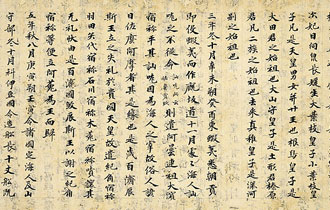Pages |
The current constitution says nothing about gender, stating only that "The Imperial Throne shall be dynastic and succeeded to in accordance with the Imperial House Law passed by the Diet." The Diet, however, has passed a law restricting the Chrysanthemum Throne to males. At the point of this writing, there are no males eligible for succession following the Crown Prince and his younger brother Prince Akishino given that the wives of both have given birth only to daughters.
General MacArthur moved to reduce the size of the Imperial Family. All daughters when they married had to leave the Imperial Family and became commoners. Distant cousins also lost their imperial family status. As a result, there is controversy today as to how to handle the succession issue. One option is to reinstate those distant cousins so that any males born of them could be eligible to become emperor. Another option is to reinstate the official concubine system that, in previous eras, resulted in a number of emperors. Yet another other option is to pass a law allowing females to ascend to the throne.
Given that there are only girls in the families of the Crown Prince and his brother, the succession problem will continue to demand a solution. Thus, if there is no son born, we can expect in the coming years that the Diet will consider laws to accommodate this new situation. We also can expect that those laws may take into account changing values in Japan with respect to gender and power.
The image of the Emperor and the Imperial Family presented to us by the Imperial Household Agency and promoted by the popular media is one of "ideal Japaneseness." The Imperial Family is shown as a loving, caring family, concerned about one another through illness and health. Much was made of the Empress Michiko massaging the legs of her ailing and bed-ridden mother-in-law not long before the dowager's death.
The Imperial Family members are often photographed visiting hospitals, senior citizen's homes, schools, facilities for the handicapped, and areas affected by natural disasters. Traditionally a member of the Imperial Family has been the honorary head of the Red Cross of Japan. The image is that the Emperor cares deeply about the well-being of his subjects, and we have no reason to think that this is not true.
The Imperial Family is also portrayed as caring about the environment and being concerned with nature. The Emperor and other family members are scientists. The Emperor himself is an accomplished marine biologist; his second son, Prince Fumihito, earned a Ph.D. in ornithology. They also are photographed climbing mountains and in other ways enjoying nature.
The Imperial Family also supports the arts, having a chamber ensemble made up of Imperial Family members. They sponsor poetry contests and submit their own entries in an annual waka event at New Year. The thirty-one syllable waka (a.k.a. tanka) is quintessentially a Japanese form of poetry, making it an appropriate venue for celebrating the richness and historical depth of Japanese culture. By participating in these uniquely Japanese activities the Emperor and the Imperial Family provide a strong symbol of Japanese ethnic, cultural and national identity.
Pages |











